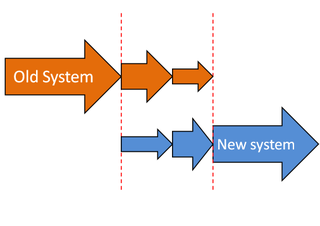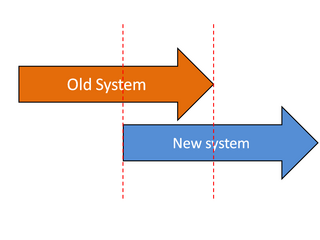Implementation
Once the management has decided to use the big bang method, and supports the changes which are needed for this, the real changing process can start. This process comprises several steps: converting the system, releasing parts of the system and training the future users. [1]
The activities in the process are explained in the table below, to state them clearly. The concepts that are used to execute the activities are in capitals.
| Activity | Subactivity | Description |
| Prepare management (see Adoption) | Determine organizational changes | The process of determining the changes that will have to take place to make the big bang possible that results in a report of organizational changes |
| Agree on organizational changes | To be able to introduce the big bang, there has to be agreement about the change-plan which results in an agreement contract. If there's no agreement a new agreement meetings are necessary or the changes need to be determined different again and again, until an agreement contract is created. | |
| Convert system | Make planning for future users | Create a plan for the people who will have to deal with the new system, so they have an overview of the events that are going to happen [1] |
| Convert data from old system | Convert data from the old system so it can be used in the new system (Koop, Rooimans and de Theye, 2003) | |
| Load data into new system | Load data the converted data into the new system [1] | |
| Test data in new system | Test data so it'll be known whether if the data will be usable in the new system [1] | |
| Execute offline trials | Execute trial with the system and with the users of the system to check whether if the system will work correct [1] | |
| Check to verify validity | Checking validity so the system can be made ready to become released (Koop, Rooimans and de Theye, 2003) | |
| Release parts | Release converted database | Release the new database which is converted from the old database [1] |
| Release produced application | Release the application which is produced for the staff [1] | |
| Release infrastructure | Release the new infrastructure [1] | |
| Prepare users | Maintain buffer of experienced staff | Create a buffer of staff who can take over the duties of the people who have to be trained in using the new system, so the daily work can go on [1] |
| Train users | Train users in preparation for the big release of the system, to create a list of trained users |
Convert the system
At first, a plan for the whole adoption process is needed. The plan allows future users to know what will happen and when they should expect certain changes, which avoids unnecessary uncertainties and therefore creates a better working atmosphere. The plan also makes clear when the real adoption takes place and gives the future users the opportunity to get ready for this change. [1] The model below shows that the activities (in the grey box) lead to outcomes (in the boxes next to the grey box) to be able to have a partial outcome: the converted system
When the plan is made and everyone knows what is expected from them, the technical changeover can start. First the old data needs to be converted into a form which is able to work with the data in the new system (Koop, Rooimans and de Theye, 2003). Then this data needs to be loaded into the new system, which results in the so-called loaded data. This loaded data needs to be tested to check the efficiency of the data and to test the level of understanding of the future users. Off-line trials need to be executed to check whether the system and the users can work together. Not only do the efficiency and the understanding need to be tested, but the validity needs to be tested to make the level of data validation clear. [1] If the data is not valid, the management need to determine the changes again and the organisation will have to prepare a different way of executing the Big bang adoption.
Release parts of the system
If all the data is valid, separate parts of the system can be released. The database which is converted from the old database needs to be released, so the new data is accessible. Next, the produced application needs to be released, so the new application can also be used. The infrastructure of the whole new system also needs to be released, so that it is clear what the system will look like and how everything is connected (Koop, Rooimans and de Theye, 2003). In this phase only separate parts are released, which don't form the new system yet, but only parts of it. All of this happens off-line: only the system developers see this, while the users are still working on the old system. The model above shows what activities need to be executed (in the grey box) by the system controller, to get the outcomes that lead to the released parts. If the release of the parts failed, the management need to determine new changes again (See Adoption; Prepare an organization for adoption).
Train the organization in using the system
If the release of the separate parts succeeded, the next step will be to prepare the users. To be able to introduce the whole new system, i.e. to adopt it, all users need to be trained in working with the new system. Without huge consequences for the production level of an organization, training everyone is only possible if there is a buffer of experienced staff who can take over the daily work of the users that need to be trained. This means that for all the people that need to be trained, there will be staff available who can take over the work, so there won't be an enormous delay of work. [1] The human resources department will create the buffer of experienced staff (activity in the grey box) by inviting applicants for the buffer. Then the users can be trained and the trained users can be listed, so a user preparation report can be written.
Poor training can have bad outcomes for an organization, as the FoxMeyer case illustrates (Scott, Vessey, 2000). This company used the big bang method to implement an enterprise resource planning (ERP) system. Wrong training was given, the assumption was made that users already knew enough about it and the wrong skills were taught. Dow Corning also had big problems with acquiring the necessary skills during their big bang ERP implementation (Scott, Vessey, 2000). Using a new system demands various skills and knowledge, which in several cases seem to be underestimated by those managing the switchover.










